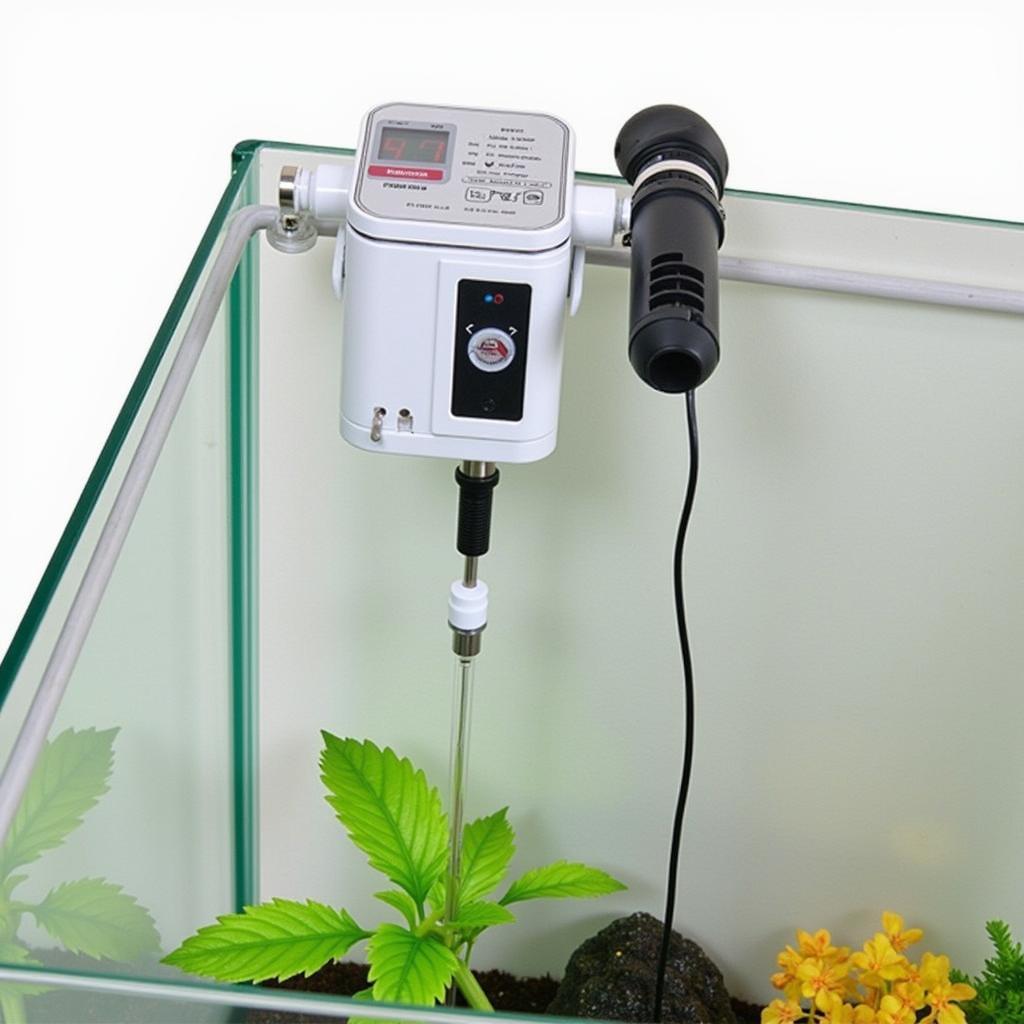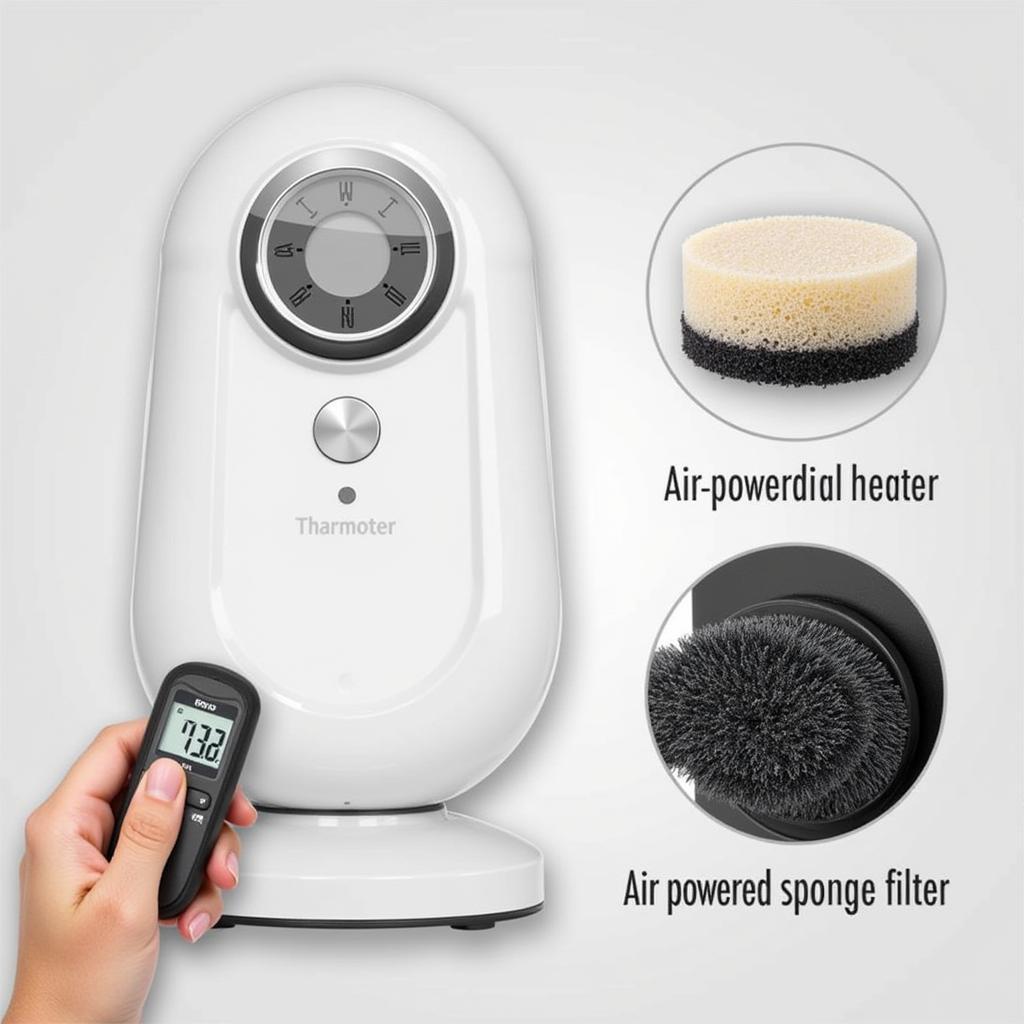A Betta Hospital Tank is a crucial tool for any betta fish owner. It provides a safe and controlled environment to isolate and treat sick or injured fish, ensuring they have the best chance of recovery. This dedicated tank differs significantly from a regular betta tank in terms of size, setup, and equipment.
Why a Hospital Tank is Essential for Betta Fish
While a regular betta tank focuses on aesthetics and the fish’s long-term well-being, a hospital tank prioritizes treatment and recovery. Here’s why:
- Isolation: Separating a sick betta prevents the spread of diseases to other fish in the main tank.
- Medication Control: A hospital tank allows for accurate dosage and monitoring of medication, preventing contamination of the main tank.
- Stress Reduction: A bare-bones setup minimizes stimulation and stress for the recovering betta.
- Easy Observation: A smaller tank makes it easier to observe your betta’s behavior and monitor their progress closely.
 Betta Hospital Tank Setup
Betta Hospital Tank Setup
Choosing the Right Hospital Tank for Your Betta
The ideal betta hospital tank should be at least 2.5 gallons, allowing for sufficient water volume to dilute waste and maintain stable water parameters. While smaller tanks can be used, they require more frequent water changes.
- Tank Size: 2.5 – 5 gallons recommended
- Material: Glass or acrylic (glass is preferred for better heat retention)
- Shape: Rectangular tanks offer better water surface area for gas exchange
Essential Equipment for a Betta Hospital Tank
Unlike a regular betta tank, a hospital tank requires minimal equipment, focusing on essential items:
- Heater: Maintaining a stable water temperature of 78-82°F is crucial for a betta’s immune system.
- Thermometer: Accurate temperature monitoring is essential for a recovering betta.
- Filter: A gentle sponge filter provides both mechanical and biological filtration without creating strong currents that can stress a sick fish.
- Air Stone (Optional): An air stone can increase oxygen levels in the water, which can be beneficial for a betta struggling to breathe.
 Essential Betta Hospital Tank Equipment
Essential Betta Hospital Tank Equipment
Setting Up Your Betta Hospital Tank: A Step-by-Step Guide
- Clean and Disinfect: Thoroughly clean and disinfect the tank, heater, filter, and any other equipment using a betta-safe disinfectant. Rinse thoroughly.
- Add Water: Fill the tank with dechlorinated water, ensuring the temperature is within the ideal range (78-82°F).
- Install the Heater and Filter: Position the heater and filter according to the manufacturer’s instructions. Allow the water temperature to stabilize.
- Add Aquarium Salt (Optional): Aquarium salt can be beneficial for some betta illnesses. Add 1 teaspoon per gallon of water.
- Acclimate Your Betta: Float the betta’s container in the hospital tank for 15-20 minutes to allow for temperature acclimation. Slowly release the betta into the tank.
Maintaining Water Quality in a Hospital Tank
Water quality is paramount for a recovering betta. Frequent water changes are crucial in a hospital tank due to the lack of a fully established nitrogen cycle:
- Water Changes: Perform daily 25-50% water changes using dechlorinated water.
- Gravel Vacuuming: If using gravel, gently vacuum the substrate during water changes to remove waste.
- Water Testing: Regularly test the water parameters (ammonia, nitrite, nitrate, pH) to ensure optimal levels.
Observing Your Betta’s Behavior and Recovery
Closely monitor your betta’s behavior for any signs of improvement or worsening symptoms:
- Appetite: Encourage eating by offering small amounts of high-quality betta food.
- Activity Level: While some lethargy is normal, excessive inactivity can be a cause for concern.
- Breathing: Rapid or labored breathing can indicate stress or illness.
- Physical Appearance: Look for any changes in color, fin condition, or signs of parasites.
 Betta Fish Recovering in Hospital Tank
Betta Fish Recovering in Hospital Tank
When to Return Your Betta to the Main Tank
The decision to return your betta to the main tank depends on their recovery progress and the nature of their illness. In general, wait until your betta has shown consistent signs of improvement for at least a week after completing any medication.
Conclusion
Setting up a betta hospital tank is a crucial aspect of responsible betta fish ownership. By providing a dedicated space for treatment and recovery, you can significantly improve your betta’s chances of overcoming illness or injury. Remember, early detection and prompt action are key to ensuring the well-being of your betta. If you’re ever unsure about your betta’s health, consult a qualified aquatic veterinarian for professional advice.
For immediate assistance, please contact us at Phone Number: 02437655121, Email: [email protected]. You can also visit us at: Số 298 Đ. Cầu Diễn, Minh Khai, Bắc Từ Liêm, Hà Nội, Việt Nam. We have a dedicated customer support team available 24/7.